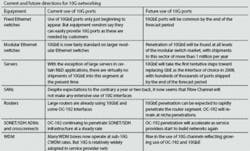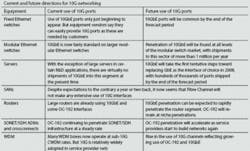The state of play in 10G
Manufacturers of optical networking equipment, modules, and components may still be pining for the good old days, but today they have more reasons for hope than for a number of years. Capital expenditures by service providers are up, and fiber optics now seems to be firmly entrenched in the corporate networking infrastructure, too. And optical networking equipment manufacturers, for the first time ever, have the opportunity to sell to a mass market, since 10-Gigabit Ethernet is showing signs of becoming the general purpose successor to Gigabit Ethernet for data communications. Unlike all previous Ethernet “flavors,” 10-Gigabit Ethernet is inherently a fiber-optic standard (although copper can be used for short distances).
CIR has just published a report on the state of the 10G market, predicting that 10G module sales will more than quadruple from 2006 to be worth $655 million by 2010. At the equipment level, the 2010 figure translates into about $1.6 billion in 10G port sales. These prospects should be encouraging to the main suppliers of optical components and modules, who still have terrible financial problems; it remains to be seen whether some of these firms haven’t lost so much money that they will be unable to survive long enough to take advantage of budding opportunities. In any case, such firms need to remember that the takeoff of the 10G market is something of a double-edged sword. The high volume of 10G products that CIR expects to be sold over the next few years is intrinsically tied to the commoditization of the 10G market, with equally rapid shrinking of margins.
While the SONET/SDH part of the 10G market will remain healthy, the growth prospects in the 10G sector lie predominantly in the 10-Gigabit Ethernet segment; by 2013, we expect 90% of total 10G modules sold to be for 10-Gigabit Ethernet applications. And the growing standardization of the market will mean that it will become increasingly important for firms in this space to adopt the right multisource agreement (MSA) at the right time. Our research indicates that XFP (and, to a lesser extent, X2) is a high-revenue growth opportunity, and we believe they will both come to dominate after 2007 or so. XENPAK and 300-pin modules will steadily lose their market shares to X2 and XFP, as the result of the latter’s better performance and footprint characteristics. The PCI-compliant XPAK will pick up in volume after the entry of servers deploying 10G ports.
Although some of the firms in the 10G space had huge war chests just a few years ago, these have now dwindled to crisis levels. Many of these firms are counting on their ability to further streamline their operations and reduce their operating costs. Component suppliers are also trying to move up the value chain to increase their margins. Most of the big players have undertaken major initiatives to restore profitability to their module operations.As a result, almost every big player in this industry has set up production facilities in China or other low-cost centers such as Malaysia. This year, Bookham is expanding its operations in Shenzhen, China. Other firms, such as Finisar and Opnext, have contracted their manufacturing to Thailand and China. An immediate consequence of the outsourcing trend is that manufacturing capacities in the U.S. and Europe are being downsized or even shut down.
Nonetheless, many of the players continue to prefer to carry out R&D and product design activities in the U.S. or Europe only. We expect the consolidation trend to continue for the next 5 to 6 years as capacity continues to be shed in the module business. Even the expected surge in the 10G business is unlikely to prevent this from occurring.Lawrence Gasman is president of CIR Inc. (Charlottesville, VA; www.cir-inc.com). He can be reached at [email protected].


